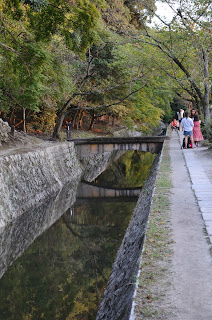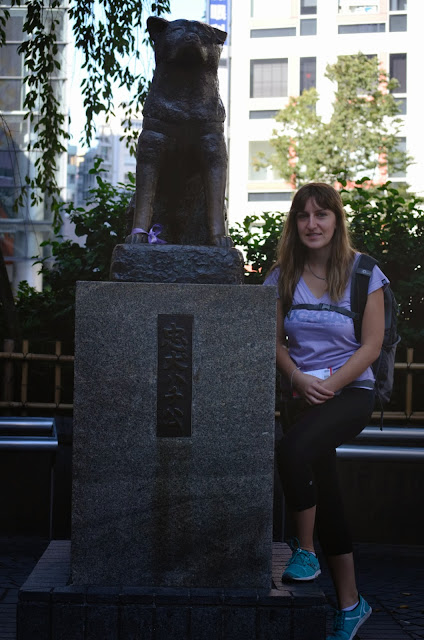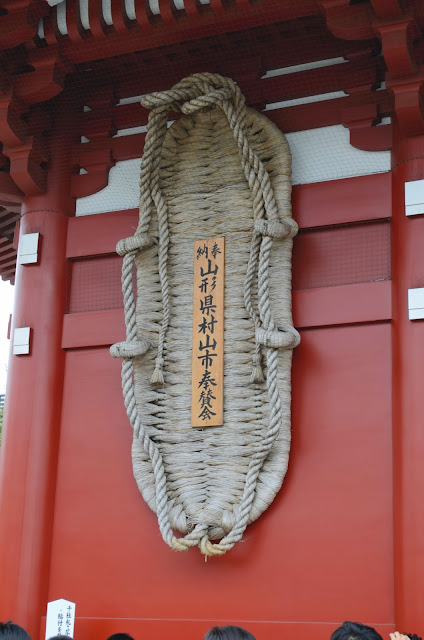Good morning, good day, and good evening world!
So we have decided to try something a little different for
our next post. Instead of giving you a blow-by-blow of all our experiences in
lovely Kyoto, we are going to outline our five favourite sights we saw in the
city. This is by no means a comprehensive list, we saw and did plenty of things
in Kyoto, but if you were to ask us what are the MUST SEE attractions, this top
five should be at the top of your list. In no particular order:
 |
| This monkey looked like he was none to happy to have his picture taken. "Damn you, paparazzi!" |
1) Tour of Arashiyama: Home of the Bamboo Grove and
Monkey Park
 |
| I think he was only there to check out the ladies |
It should come as no surprise to you folks that the area
containing a monkey reserve would make this list. Mike’s adoration for all
things monkey is bordering on obsessive and this long trek up a winding, steep
and picturesque mountain is definitely worth your trouble. The view from the
top alone is worth the trip, but in addition, you are also treated with the
company of a family of over 200 plus Japanese macaques. You’ll tread lightly as
you snap photos of Kyoto from up on high, all the while making sure not to step
on any wayward tails, or god forbid, baby monkeys. For a small fee (only 300
yen!) you can also buy a bag of diced fruit which you can feed to the monkeys,
from inside a caged cabin of course. Do this and you’ll instantly become the
most popular person on monkey mountain.
 |
| Yup, that's a lot of bamboo. |
.jpg) |
| Reach for the sky! |
2) Ginkaku-ji and the Path of Philosophy
 |
| How very philosophical! |
In the mood for a bit of enlightenment? Who isn’t, am I
right? Well you’ve come to the right place! Kyoto is home to hundreds of
temples and shrines and while you may get sick of temple-hopping after experiencing
a handful of them, we’ve decided to highlight our favourites to save you the
trouble of narrowing it down. First up is the Ginkaku-ji. This temple is
located at the end of a long winding path built next to a small canal. The
path, called Tetsugaku-no-Michi, or more commonly “The Path of Philosophy,” a
fantastically tranquil (albeit long) walk along the canal. It is far enough
away from the main roads that you barely hear any of the hustle and bustle of
busy Kyoto and is particularly beautiful in the fall as the leaves of all the
surrounding trees begin to change.
 |
| No, this wasn't taken with a fish-eye lens. |
Follow this path to the end and you’ll reach one of Kyoto’s
top sights, the Ginkaku-ji. What sets
this temple apart is its immaculately maintained zen garden, complete with
groomed white sand. The sand is not merely raked, as with most zen gardens, but
is actually built into small sand sculptures. In addition to the sand, the
garden itself is full of tiny shrines found in the middle of forest groves,
ponds and cave rock that make it even more unique than your typical temple. Finally,
if the walk doesn’t turn your crank, there are dozens of rickshaw operators who
will eagerly bring you up the hill to your final destination (all for a
small/hugely expensive fee of course).
 |
| I hope we're going the right way. |
3) Gion at Night
After a long day of walking, why not end your night with
even more walking! That’s just what we did and clocking in at over 20
kilometres, we decided we weren’t quite tapped out (or just refused to admit it
to each other) and headed to the entertainment and geisha district of Kyoto,
Gion. This area is home to Hanami-koji, which some call the most beautiful
street in all of Asia. After experiencing its lantern lit, cobble stoned
street, we inclined to agree (although we’ve yet to visit all of Asia, so take
our opinion for what it’s worth). This street is full of high-end restaurants and
teahouses, and while it ended up costing us a pretty penny, the food and the
service at the restaurant we chose, Wabiya Korekido, was well worth the
expense. Our seven course meal was made directly in front of us and even
required a bit of work on our part too. Nothing too major though, stirring
mostly. Even Mike can’t really screw that up!
 |
| It's a beautiful walk until you almost get run over by a car. You can even see one poking through the crowds. |
 |
| Delicious, even if you have to do a bit of work. |
 |
| They look so sad, even if they're dancing was beautiful. |
As mentioned earlier, Gion is the geisha district of Kyoto
and wandering around the area, you’ll probably happen to run into one or two
walking around, entertaining a group of businessmen. It took a lot of effort on
our part not to rudely interrupt and snap a picture of these unique hostesses.
Thankfully, Hanami-koji is also home to the Gion Corner, which is found at the
end of the street and is comprised of an hour-long show which explains and
performs a variety of different Japanese cultural traditions, including our
favourite, the geisha dance. This was actually quite inexpensive (for Japan
standards) and if you can deal with 50 plus annoying tourists snapping pictures
of the presenters during their performances, it is well worth experiencing.
4) Kinkaku-ji Temple
Our final temple on the list is the golden floating pavilion
of Kinkaku-ji. As Kyoto is jam-packed with various temples and shrines, it
really does take something unique to really stand out. The first temple we saw
in Japan was amazing, but when you realize that there are basically hundreds
more pretty much like it, visiting each of them becomes quite rote. Thankfully,
the Kinkaku-ji temple stands out as not only one of the top sights in Kyoto,
but perhaps one of the top in all of Japan. This golden palace is planted on
the edge of an amazing pond which, weather permitting, is still as glass and
reflects the image of the temple in beautiful, jaw-dropping splendor that can
only exist in nature. Unfortunately, this is one of the top sights in Japan and
crowds of Japanese elementary school students and busloads of Chinese tourists
are pretty much unavoidable. If you can stomach large, pushy crowds and
interrupting hundreds of posed photos, than we definitely recommend a visit.
 |
| You've got to love how gold shimmers in the sunshine! |
4) The Kyoto International Manga Museum
 |
| MANGA |
 |
| A poster for the museum's special exhibit |
If you know anything about Mike, then you know there was no
way we were going to turn down the opportunity to visit a museum devoted
entirely to the appreciation of the comic book storytelling. This facility,
which is a former 18th century Japanese school, is absolutely filled
to the brim with every manga series imaginable (over 300,000 copies at last
count). For those not in the know, manga is Japan’s version of comic books. The
Japanese treat this medium very differently than we do back home though and the
fact that they have a museum devoted entirely to the explanation, preservation
and appreciated of both the storytelling and the art of manga should illustrate
just how seriously Japan takes its comic books. While we couldn’t really grab a
book, sit down and read a few chapters like many of the Japanese patrons, we
did still enjoy flipping through, enjoying the art and learning about the
history of not only manga, but illustrated storytelling in general. Mike
particularly appreciated the section devoted to “American Manga” as it was nice
to see Superman, Batman and Spider-Man get their artistic due in a museum, even
if it was half a world away. The museum even offers workshops for those
interested in learning and honing their own manga drawing skills, unfortunately
these were only offered on weekends and missed that particular opportunity.
 |
| Unfortunately we weren't allowed to take pictures in the museum, so this is the best you'll get. Sorry! |
Walking the halls of the museum, we heard the booming voice
of one traditionally-dressed Japanese man. As we followed his voice, we found
him in front of a crowd of people, standing next to an odd display case which
contained sliding pictures. We learned this was called kami-shibai (a humorous
traditional Japanese sliding-picture show) and even though we didn’t understand
a word this man was saying, his exuberance and knack for story-telling came
broke through the language barrier. Mike even won Maja a replacement for her
wedding ring by correctly identifying Astro Boy in one of the sliding pictures!
Now if only he can talk her into selling the old one and using the plastic
replacement, we’ll have an extra few dollars ready for our next trip! And
before you ask: Yes, Maja did indeed actually enjoy the Manga Museum so it is
well worth the trip even if you are not a comic fan!
We hope you enjoyed our list of our favourite Kyoto sights
and we hope they will be useful if you ever plan on visiting the area. We
definitely recommend the city as it’s an excellent combination of the quiet
peacefulness of a small town like Takayama, with the interesting sights and
experiences that are found in a larger city like Tokyo. All of the pluses, none
of the minuses!
 |
| Dressed up and ready for our Shabu-Shabu dinner at our Kyoto Ryokan. |
Let us know if you prefer this new format for our posts, we
had a lot of fun putting it together, debating which sights will make it and
which will end up on the chopping block. We even had fun trying to desperately
to recover this file when we thought it was lost when the laptop unexpectedly
shutdown. Okay, so that last part wasn’t so fun, but it was an experience
nonetheless.
Namaste,
M&M
M&M













































